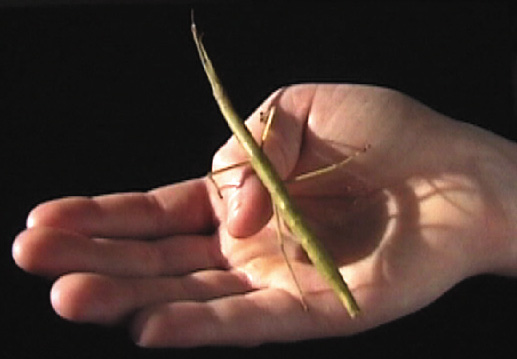 I
have found walking sticks to be facinating insects. They are
colourful, easy to keep, and useful for teaching both students and
the general public about insects, science, and nature.
I
have found walking sticks to be facinating insects. They are
colourful, easy to keep, and useful for teaching both students and
the general public about insects, science, and nature.
 I
have found walking sticks to be facinating insects. They are
colourful, easy to keep, and useful for teaching both students and
the general public about insects, science, and nature.
I
have found walking sticks to be facinating insects. They are
colourful, easy to keep, and useful for teaching both students and
the general public about insects, science, and nature.
I first put up this page back in September, 1997 and have had many people visit. Their comments and questions have inspired me in 2001 to improve and expand this page to serve a wider audience. These pages describe the information that I have obtained about the care and maintenance of my Walking Sticks over the last few years. Recently (2008), it is clear that this species has become a serious pest in Southern California and I have modified this site to advertise this concern. Please see the warnings below and don't let your pets escape in to the wild.
I have confined this site to one walking stick, the Indian Walking Stick Insect (Species: Carausius morosus) . There are many other species of walking sticks and information about them can be found at other sites listed in the "References" link.
Warning: Don't let these insects escape into the wild and cause ecological damage as a feral population. This is a real possibility with this species! Be careful and responsible. If you have them, DON'T let them escape! (See the warning section for more details.) As with any pet, always be responsible and if you keep them make sure that they don't escape.
Please use the links on the left to navigate through this site.
The escape of this species into the wild has caused ecological problems in Southern California and Britain. The presence of the Indian walking stick in the wild in Southern California, specifically San Diego, is a concrete example of the damage that can be done by feral walking stick insects. They have been in southern California since before 2001 and have been expanding their range over the years (see links below). As an example, the Members of the Ocean Beach Community Garden, San Diego, have been having difficulty with feral walking stick insects and have asked me to post the following message: WARNING • Stick Insects can also be Pests! Just as with any Pet... it is very important that you are responsible for it so please read below.
Since Sept 29 '97 you are
visitor number  .
.
The Southern California problem
Non-native Stick insects should never be released into the wild due to the risk that they could reproduce and cause damage to an ecosystem where they are not normally found - non native species are considered plant pests. This includes making sure any eggs are disposed of as well, by crushing, boiling, or burning, as no special care is needed for many species' eggs to hatch. If you are in the United States or Canada, tropical species such as the Indian Walking sticks are considered plant pest and a permit (United Stated Department of Agriculture or Canadian Food Inspection Agency) is required to import them (and be granted only to secure instutions. In other areas, check with the appropriate government agency about legality (e.g. a Department of Agriculture or similar agency)
| This is a unfortunate example of the damage that can be done by feral walking stick insects. Here is a photo from the San Diego area that shows a number of walking sticks an the level of the infestation. I count 44 insects; how many do you count? (Photo taken by Judy Swink, San Diego, and obtained from Ruth Hoffman, Ocean Beach Community Gardens; used with permission. ) |
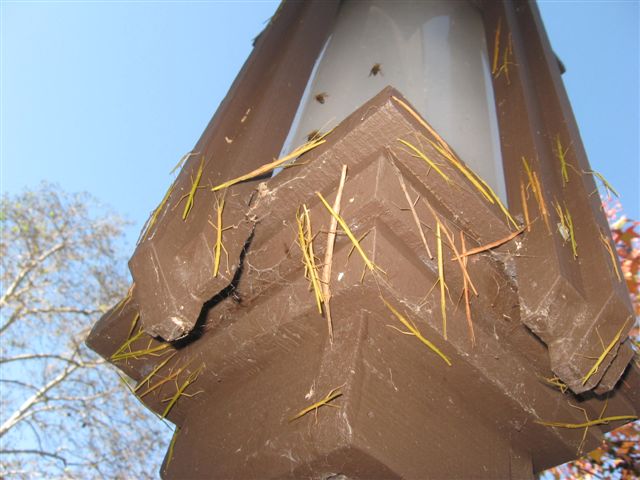 |
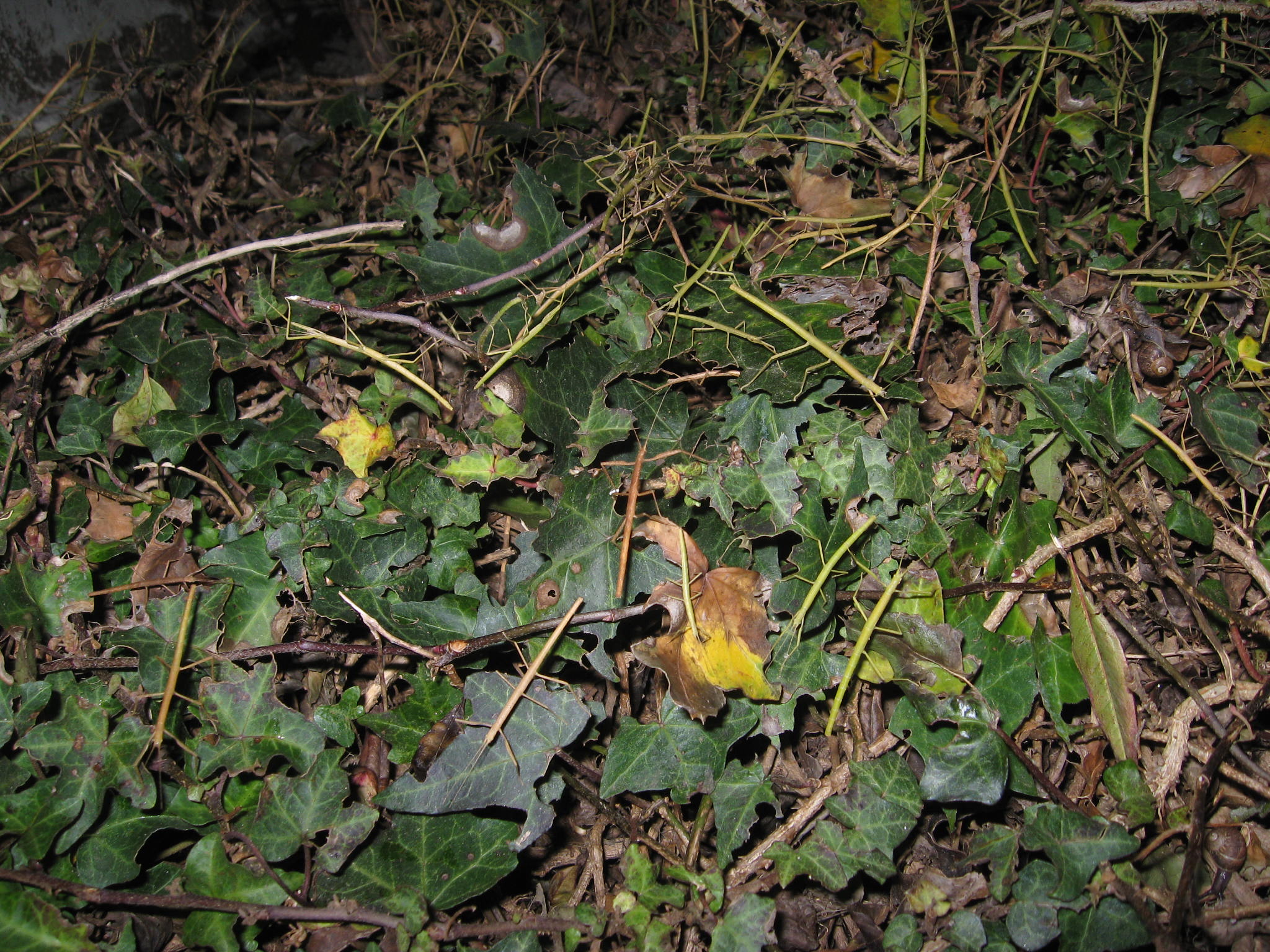 |
Here is another example of the damage that can be done by feral walking stick insects. The photo was taken with a flash after 10 PM in early January, in an ivy bed adjacent to the front steps of a house. The insects clearly prefer the ivy over the neighboring bushes and lilies. I count over 60 insects; how many do you count? (Photo taken by Judy Swink, San Diego; used with permission. ) |
Also see the following links:
http://forums.gardenweb.com/forums/load/calif/msg0916043126401.html
http://www.signonsandiego.com/uniontrib/20041226/news_1m26sticks.html
http://exoticpets.about.com/cs/insectsspiders/a/stickinsects.htm
The Indian walking stick can also be found in the wild in Britain (http://www.uksafari.com/stickinsects.htm). Supposedly it is legal to keep them as a pet in Britain (http://www.petbugs.com/caresheets/C-morosus.html) and one can buy them from British pet suppliers (http://www.crafts-flowers.co.uk/page7.html). It has been claimed that they cannot overwinter in the British climate (http://phasmid-study-group.org/en/content/Naturalised-British-Stick-Insects-Malcolm-Lee) so they my not be as serious a feral pest as Southern California.
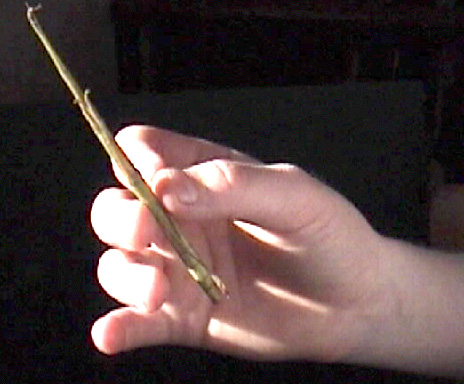 Walking
Sticks are insects. They have six legs and a chitin exoskeleton. They
belong to the Order Orthoptera, which includes not only walking
sticks, but also grasshoppers, katydids, crickets, praying mantids,
and cockroaches. Walkingsticks belong to the Suborder Phasmatodea,
Family Phasmatidea which includes both walkingsticks (which look like
sticks) and leaf insects (which look like leaves). I will not deal
with leaf insects here but they, too, are interesting
insects.
Walking
Sticks are insects. They have six legs and a chitin exoskeleton. They
belong to the Order Orthoptera, which includes not only walking
sticks, but also grasshoppers, katydids, crickets, praying mantids,
and cockroaches. Walkingsticks belong to the Suborder Phasmatodea,
Family Phasmatidea which includes both walkingsticks (which look like
sticks) and leaf insects (which look like leaves). I will not deal
with leaf insects here but they, too, are interesting
insects.
There are several thousand speices of Walking Stick insects and many are kept as pets. The ones I had, and describe here, are Indian Stick Insects (Species: Carausius morosus; Pronounced: Ca-rau-si-us mor-o-sus). They are also called the Laboratory Stick Insect because they are easily kept in the laboratory for research experiments. They range in colour from a dark-brown (almost black) to bright green, with the younger stages usually being browner. Walking Sticks take several months (4-6) to grow from a first instar stage, which is about 1 cm long (1/2 inch), to an adult of about 10 cm (4 inches).
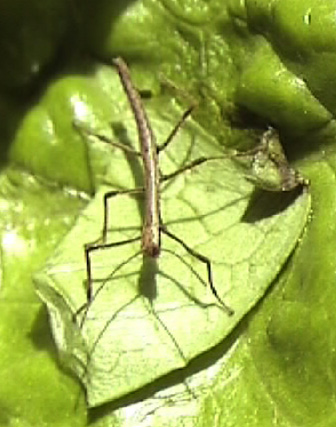 Advantages
of Walking Stick Pets:
Advantages
of Walking Stick Pets:
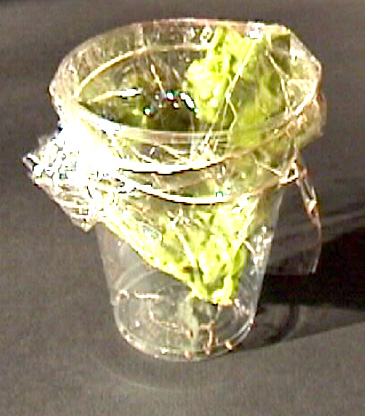 Your
pets should be kept in a cage or container that is large enough for
them to walk around and small enough that they will easily find the
food you give them. As they grow up you will have to increase the
size of the cage. You can start with a plastic cup (photo on the
right) for the hatchlings, move up to a 500 ml jar for the younger
stages but will have to move to a 2 litre or larger container for the
adults, especially if you have more than one insect. These containers
should have good ventilation to permit the insects to "breath" and
also to reduce the humidity and thereby inhibit the formation of mold
and fungus in the container. I put a layer of dry paper towel on the
bottom of the container which allows the easy removal and clean up of
the insect's "wastes".
Your
pets should be kept in a cage or container that is large enough for
them to walk around and small enough that they will easily find the
food you give them. As they grow up you will have to increase the
size of the cage. You can start with a plastic cup (photo on the
right) for the hatchlings, move up to a 500 ml jar for the younger
stages but will have to move to a 2 litre or larger container for the
adults, especially if you have more than one insect. These containers
should have good ventilation to permit the insects to "breath" and
also to reduce the humidity and thereby inhibit the formation of mold
and fungus in the container. I put a layer of dry paper towel on the
bottom of the container which allows the easy removal and clean up of
the insect's "wastes".
Make sure the container has a stick or other place where the insects can climb up and hang down. They need to hang from such a place in order to shed their skin when they moult. They need to moult several times before becoming an adult.
It is also advantageous for the container to be clear plastic or glass so that you can easily see in and enjoy their activities.
I fed my insects Romaine lettuce (the green part not the white basal stalk) that has been washed under the kitchen tap. I remove any off-colour or damaged portions, too. The lettuce should be changed, along with the bottom paper, every 3-7 days, depending on the amount eaten and the presence of fungus.
They will also eat leaves from raspberries, privet, and many other related plants if given the chance. This is usually only possible during the summer when leaves are plentiful.
The adults can easily be picked up between finger and thumb. The younger instars may be damaged with clumsy handling so it is better to let them climb onto a piece of paper to examine or transfer them. They are nocturnal, meaning that they are most active at night, so you may want to keep their daily light-dark cycles such that they are active when you can observe them. During the day they are usually inactive and still unless they are disturbed.
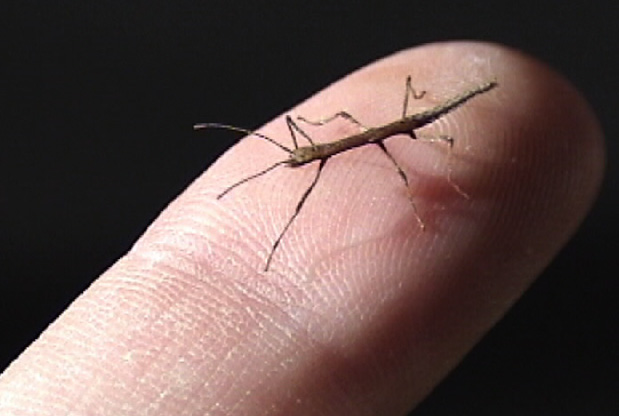 Many
walking sticks, including the Indian Walking Stick, are
parthenogenetic. The population consists almost exclusively of
females. These females are able to lay fertile eggs (without mating
or the presence of males) which develop into more females, etc. Their
eggs are oval in shape, dark brown, 2-3 mm long, and have a
lighter-coloured knob at one end. When they hatch, this knob comes
off and the walking stick climbs out. The eggs hatch after 10-12
weeks at room temperature. After they hatch, the egg shell often
remains attached. It will fall off after a few days so there is no
need to remove it by hand. Hatchlings are about 1 cm long (see photo
on the right).
Many
walking sticks, including the Indian Walking Stick, are
parthenogenetic. The population consists almost exclusively of
females. These females are able to lay fertile eggs (without mating
or the presence of males) which develop into more females, etc. Their
eggs are oval in shape, dark brown, 2-3 mm long, and have a
lighter-coloured knob at one end. When they hatch, this knob comes
off and the walking stick climbs out. The eggs hatch after 10-12
weeks at room temperature. After they hatch, the egg shell often
remains attached. It will fall off after a few days so there is no
need to remove it by hand. Hatchlings are about 1 cm long (see photo
on the right).
They grow by moulting (shedding of the cast skin. There are about five moults (I'm not sure of the exact number). Each moult allows the skin to increase in size. It is important to have one or more sticks in the cage so that the insects can use them to moult. The moulting process involves them crawling out of their old skin and this can best be done using gravity to help them out. They need somewhere that they can hang from while they moult. The absence of a stick or lid that they can hang from will severely hamper their ability to moult successfully. An unsuccessful moult will kill them.
When they reach adulthood the moulting stops and it remains the same size for several months (the adult lifetime). During adulthood the primary task is laying eggs. One female can lay several hundred eggs in her lifetime of several months.
Pet walking sticks are quite common in Europe, especially the U. K. (I guess it goes along with gardening.) There are several suppliers in England, but as far as I know they will not ship to North America. In any case, importing exotic pets is usually against custom regulations.
I am located in Alberta, Canada and these insects are officially not permitted to be kept with out a federal permit. I'm not sure about the situation in the USA, but the situation is likely similar.
I currently (Januuary '09) don't have any and have not had any for many,many years.
Please see the warning above.
There are several instances where experiments in space have used walking sticks.
The "facts" below have been taken from Wigglesworth's The Priniciples of Insect Physiology. 6th Edition (1965)(2). They are presented in the order in which they appear in the book. The page number is given along with the original reference in many cases.:
Several experiments can be done by students in the primary or secondary school classroom using walking sticks.The two listed below are "long-term" in that they require minor effort over several months. In the future I hope to find/create some other ones that are more short term.
The colour of adult insects varies from almost black to very light green. This is influenced by the "colour" of their envirnment while they are growing up. This is probably an adaptive feature that helps them blend into their background and avoid detection by predators.
This can be tested/demonstrated by growing two or more groups of insects in different "coloured" environments.
Procedure:
The environment can affect how well eggs develop and the frequency of them hatching. In this experiment you can test the effect of cold treatment on the likelyhood of the eggs hatching.
Procedure:
NOTE: Cold treatment is only one of several "environment treatments" that are possible. Think of some more and test them using this experimental system. In the "Interesting Facts" section, see the effect of temperature on the appearance of male insects.
Much of what I learned
about looking after walkingsticks came from the book:
A
step-by-step book about STICK INSECTS by David Alderton
(1992, T.F.H. Publications),
which I found at a local, superior
quality pet shop.
1. D. J. Borror and R. E.
White.
Peterson Field Guides - Insects. America north of
Mexico. 1970. Houghton Mifflin Co. Boston.
2. V. B. Wigglesworth.
The Principles of Insect Physiology. 6th Edition. 1965.
End